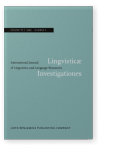Vol. 16:2 (1992) ► pp.395–420
Dictionnaires Pour Voyageurs, Dictionnaires Pour Marchands ou la Polyglossie au Quotidien aux XVIe et XVIIe Siecles
The cultural phenomenon of Renaissance "polyglossia" became a very important publishing phenomenon which spread considerably over space — the whole of Central Europe — and time — from the end of the 15th to the middle of the 18th Century. This article examines two sets of multilingual dictionaries, "Solenissimo Vochabuolista" and "Berlaimont", considering both external and internal aspects of these works, such as concrete presentation features of the volumes, number of languages included (twelve different languages, up to eight in one edition), and content evolution. "Solenissimo Vochabuolista" and especially "Berlaimont", are not just dictionaries: they also include prayers, conversations and even patterns of letters and contracts. This touch with reality represents the key factor in their immense popularity with a public of travellers, merchants, people generally interested in the practical knowledge of language/s for the sake of everyday communication.
Cited by
Cited by 3 other publications
This list is based on CrossRef data as of 5 july 2024. Please note that it may not be complete. Sources presented here have been supplied by the respective publishers. Any errors therein should be reported to them.
